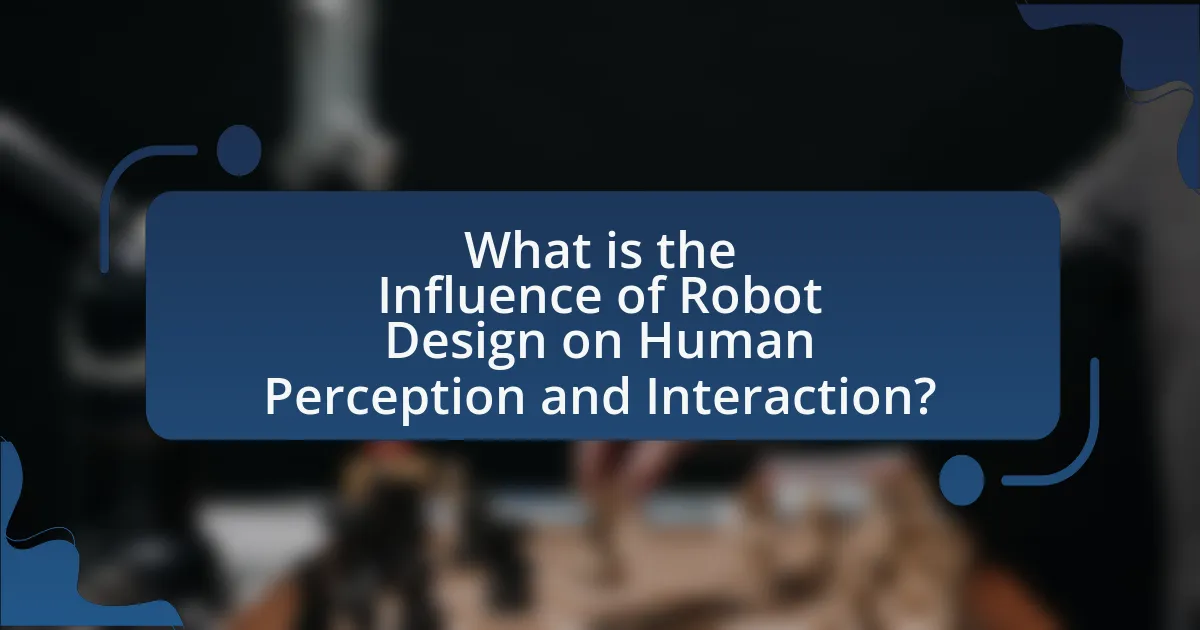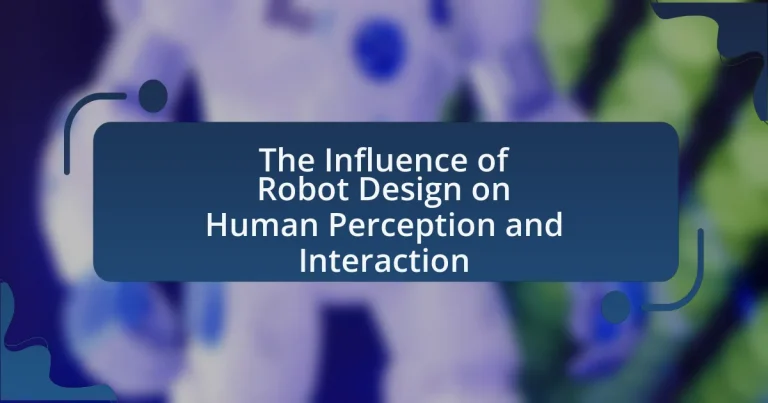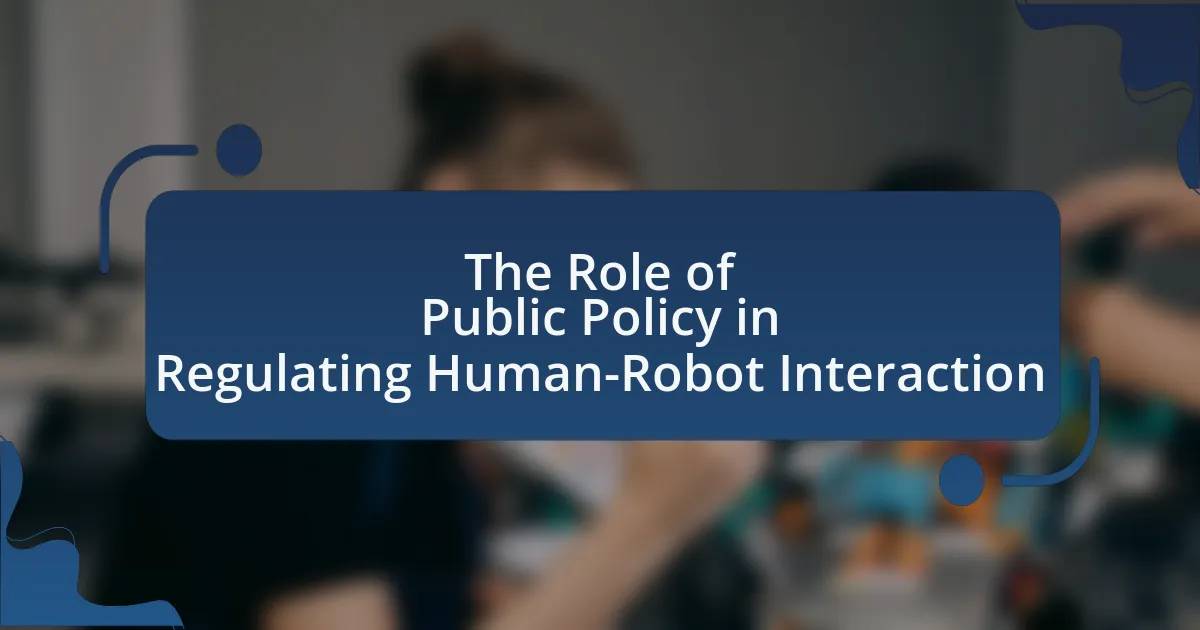The article examines the influence of robot design on human perception and interaction, highlighting how design elements such as human-like features, color, shape, and texture affect emotional responses and trust levels. It discusses the importance of understanding human perception in robot design to enhance user acceptance and collaboration, emphasizing the role of cultural context and social dynamics in shaping interactions. Key factors influencing interaction include physical appearance, behavior, communication style, and functionality, with a focus on best practices for optimizing robot design to improve usability and emotional engagement. The article also addresses common pitfalls in robot design that can hinder user experience and safety.

What is the Influence of Robot Design on Human Perception and Interaction?
Robot design significantly influences human perception and interaction by shaping emotional responses and trust levels. Research indicates that robots with human-like features, such as facial expressions and body language, elicit more positive emotional reactions from users, enhancing engagement and comfort during interactions. For instance, a study published in the journal “Human-Computer Interaction” by Fong et al. (2003) demonstrated that users preferred robots with anthropomorphic characteristics, which led to increased willingness to interact and collaborate with them. Additionally, the design elements, such as color, shape, and size, can affect users’ perceptions of a robot’s capabilities and reliability, impacting their overall experience. Thus, effective robot design is crucial for fostering meaningful human-robot interactions.
How does robot design impact human emotional responses?
Robot design significantly impacts human emotional responses by influencing perceptions of trust, empathy, and comfort. For instance, robots with human-like features, such as facial expressions and body language, can evoke stronger emotional connections, as evidenced by studies showing that users respond more positively to robots that exhibit social cues similar to humans. Research conducted by Breazeal et al. (2004) demonstrated that participants felt more engaged and emotionally connected to robots designed with expressive faces compared to those with minimalistic designs. This indicates that the aesthetic and functional aspects of robot design play a crucial role in shaping human emotional experiences and interactions.
What design elements evoke positive emotions in humans?
Design elements that evoke positive emotions in humans include color, shape, texture, and symmetry. Colors such as blue and green are often associated with calmness and tranquility, while warm colors like yellow and orange can evoke happiness and energy. Shapes that are rounded and soft tend to be perceived as friendly and approachable, contrasting with sharp, angular shapes that may evoke discomfort. Textures that are smooth and soft can enhance feelings of comfort and safety. Additionally, symmetry in design is linked to beauty and harmony, which can lead to positive emotional responses. Research indicates that these elements significantly influence human perception and interaction, particularly in the context of robot design, where a friendly appearance can enhance user acceptance and emotional connection.
How do negative design features affect human perception?
Negative design features adversely affect human perception by creating feelings of discomfort, distrust, or aversion towards the object or interface. For instance, research indicates that robots with unappealing aesthetics or awkward movements can evoke negative emotional responses, leading to decreased user engagement and reluctance to interact. A study by MacDorman and Cowan (2007) found that participants rated robots with less favorable designs as more threatening and less trustworthy, demonstrating that design flaws can significantly skew human emotional and cognitive responses.
Why is understanding human perception important in robot design?
Understanding human perception is crucial in robot design because it directly influences how users interact with and accept robotic systems. Effective robot design that aligns with human perceptual cues enhances usability and fosters trust, leading to improved human-robot collaboration. Research indicates that robots designed with human-like features, such as facial expressions and body language, can significantly increase user comfort and engagement, as demonstrated in studies like “The Uncanny Valley” by Mori, which highlights the importance of relatable design in robotics.
How does human perception influence user acceptance of robots?
Human perception significantly influences user acceptance of robots by shaping individuals’ attitudes and emotional responses towards robotic systems. Positive perceptions, such as viewing robots as helpful and friendly, enhance acceptance, while negative perceptions, like fear or distrust, hinder it. Research indicates that design elements, such as appearance and behavior, play a crucial role in shaping these perceptions; for instance, robots that exhibit human-like features or social behaviors are often perceived more favorably. A study by Bartneck et al. (2009) found that users are more likely to accept robots that they perceive as relatable and trustworthy, demonstrating the direct correlation between perception and acceptance.
What role does cultural context play in human-robot interaction?
Cultural context significantly influences human-robot interaction by shaping user expectations, behaviors, and acceptance of robots. Different cultures have varying norms, values, and communication styles that affect how individuals perceive and interact with robotic systems. For instance, research by K. K. Lee et al. in “Cultural Differences in Human-Robot Interaction” published in the International Journal of Social Robotics highlights that in collectivist cultures, users may prefer robots that exhibit social behaviors aligned with group harmony, while individualistic cultures may favor robots that emphasize personal autonomy. This cultural variability necessitates tailored robot designs to enhance user experience and effectiveness across diverse cultural settings.
What are the key factors in robot design that affect interaction?
The key factors in robot design that affect interaction include physical appearance, behavior, communication style, and functionality. Physical appearance influences user perception; for instance, robots designed with human-like features tend to elicit more positive emotional responses from users, as evidenced by studies showing that humanoid robots can enhance user engagement. Behavior, including responsiveness and adaptability, affects how users perceive the robot’s intelligence and reliability; research indicates that robots that can adjust their actions based on user feedback foster better interaction. Communication style, encompassing verbal and non-verbal cues, is crucial for effective interaction; studies reveal that robots employing natural language processing and appropriate body language improve user comfort and trust. Lastly, functionality, which refers to the robot’s ability to perform tasks effectively, directly impacts user satisfaction and willingness to interact, as demonstrated by user studies highlighting the importance of task efficiency in fostering positive experiences.
How do physical attributes of robots influence user trust?
Physical attributes of robots significantly influence user trust by affecting perceptions of reliability, safety, and approachability. For instance, robots designed with human-like features, such as facial expressions and body language, tend to foster greater trust among users due to their familiarity and relatability. Research conducted by Bartneck et al. (2009) indicates that users are more likely to trust robots that exhibit anthropomorphic characteristics, as these features enhance emotional connections and reduce perceived threat levels. Additionally, the material and design quality of a robot can impact user confidence; robots made from durable materials and with a polished appearance are often perceived as more competent and trustworthy. Thus, the physical design elements of robots play a crucial role in shaping user trust through psychological and emotional responses.
What design features enhance usability and accessibility for users?
Design features that enhance usability and accessibility for users include intuitive navigation, clear visual hierarchy, and adaptable interfaces. Intuitive navigation allows users to easily find information and complete tasks, which is supported by studies showing that users prefer designs that minimize cognitive load. A clear visual hierarchy, achieved through effective use of color, contrast, and typography, helps users quickly identify important elements, as evidenced by research indicating that well-structured layouts improve user comprehension and retention. Adaptable interfaces, which can be customized to meet individual user needs, enhance accessibility for diverse populations, including those with disabilities, as demonstrated by guidelines from the Web Content Accessibility Guidelines (WCAG) that emphasize the importance of flexibility in design.
How can robot design be optimized for better human interaction?
Robot design can be optimized for better human interaction by incorporating anthropomorphic features, intuitive interfaces, and adaptive behaviors. Research indicates that robots with human-like characteristics, such as facial expressions and body language, enhance emotional engagement and trust among users. A study by Fong et al. (2003) published in the IEEE Transactions on Robotics and Automation found that users responded more positively to robots that exhibited social cues similar to humans. Additionally, intuitive interfaces, such as touchscreens or voice commands, facilitate easier communication and control, leading to a more seamless interaction experience. Furthermore, adaptive behaviors that allow robots to learn from user interactions can improve personalization and responsiveness, making the interaction more relevant and effective.
What are the implications of robot design on social behavior?
Robot design significantly influences social behavior by shaping human perceptions and interactions with technology. For instance, robots designed with human-like features tend to elicit more empathetic responses from users, as evidenced by studies showing that people are more likely to engage with robots that exhibit facial expressions and body language similar to humans. Research conducted by Breazeal et al. (2004) demonstrated that social robots, when designed to be relatable, can enhance cooperation and trust in collaborative tasks. Furthermore, the aesthetic and functional aspects of robot design can affect user acceptance and emotional attachment, impacting how individuals interact with these machines in various settings, such as healthcare and education. Thus, the implications of robot design extend beyond functionality, influencing social dynamics and emotional connections between humans and robots.
How does robot appearance affect social dynamics in groups?
Robot appearance significantly influences social dynamics in groups by affecting human perceptions, interactions, and emotional responses. Research indicates that robots designed with human-like features, such as facial expressions and body language, tend to elicit more positive social interactions and trust among group members. For instance, a study by Bartneck et al. (2009) demonstrated that participants were more likely to cooperate with robots that had anthropomorphic characteristics compared to those with mechanical designs. This suggests that the visual design of robots can enhance social cohesion and facilitate communication within groups, ultimately impacting collaborative efforts and group dynamics.
What are the effects of anthropomorphism in robot design?
Anthropomorphism in robot design significantly enhances user engagement and emotional connection. When robots exhibit human-like features or behaviors, users are more likely to perceive them as relatable and trustworthy. Research indicates that robots designed with anthropomorphic traits can improve user acceptance and interaction quality, as seen in studies where participants preferred robots with human-like appearances over mechanical designs. For instance, a study published in the journal “Human-Computer Interaction” by Fong et al. (2003) demonstrated that users responded more positively to robots that displayed facial expressions and gestures similar to humans, leading to increased cooperation and satisfaction during interactions.
What best practices should be followed in robot design for improved interaction?
Best practices in robot design for improved interaction include ensuring user-friendly interfaces, incorporating social cues, and prioritizing safety. User-friendly interfaces, such as intuitive controls and clear feedback mechanisms, enhance usability and engagement, as evidenced by studies showing that users prefer robots that are easy to operate. Incorporating social cues, like facial expressions and gestures, fosters emotional connections and improves communication, supported by research indicating that robots displaying human-like behaviors are perceived as more relatable. Prioritizing safety through design features, such as rounded edges and fail-safes, is crucial, as safety concerns can significantly hinder user acceptance and interaction.
How can user feedback be integrated into the design process?
User feedback can be integrated into the design process by employing iterative design methodologies that prioritize user input at various stages. This approach involves collecting feedback through surveys, usability testing, and focus groups, which allows designers to understand user needs and preferences. For instance, a study by Nielsen Norman Group highlights that usability testing can reveal critical insights about user interactions, leading to design adjustments that enhance user experience. By continuously incorporating user feedback, designers can create products that better align with user expectations, ultimately improving satisfaction and usability.
What are the common pitfalls to avoid in robot design?
Common pitfalls to avoid in robot design include neglecting user experience, overlooking safety considerations, and failing to ensure adaptability. Neglecting user experience can lead to robots that are difficult to interact with, which diminishes user satisfaction and effectiveness. Overlooking safety considerations can result in accidents or injuries, as highlighted by the fact that 30% of industrial robot accidents are due to inadequate safety measures. Failing to ensure adaptability can limit a robot’s functionality in diverse environments, as robots that cannot adjust to varying conditions often become obsolete quickly.





